Intro
Estimated reading time: 8 minutes
I think most small power boat operators operate in similar patterns; run the boat out on the water for a bit, then anchor out in a quiet place for fishing or picnicking with family and guests. Safe anchoring isn’t hard, but if done incorrectly can cause problems.
Over the years of owning small power boats (18 foot runabouts), I’ve come up with a few for making anchoring easy and safe. I feel these hacks apply to all recreational power boats at least under 21 feet length.
Anchoring Basics
Coast Guard boating regulations strongly recommends all boat operators have at least one anchor on board, properly sized to hold the boat under normal weather conditions. A proper anchor system includes the actual anchor, a length of chain, and line (rope). The combination of anchor chain and line is called the “rode.” The anchor is hooked to one end of the chain, and the other end of the chain is hooked to the line.
The chain adds weight to your anchor, and helps hold the anchor flat so it can properly hook on the bottom. For the attached line, a common length is 100 feet. The recommended ratio of length of anchor line to depth of water is a minimum 7:1 – seven feet of line for every one foot of water depth. You may need up to a 10:1 ratio if anchoring in strong winds or current. Anchoring in ten feet of water means a minimum seventy feet of line. Most anchor line is sold in 100 foot, 125 foot, or 150 foot spools. For line diameter, go with the same diameter as your mooring lines (typically 3/8 inch).
There are a number of different design anchors, and selecting an anchor could be a post all by itself. To keep this simple; If your boat comes with the manufacturer’s-provided anchor, just use what the manufacturer provided.
I have two anchors for my 18-foot 2010 Bayliner 175BR runabout “Sea Dragon.” I normally only carry one, the Bayliner-provided fluke anchor that came with my boat, unless I plan on pulling up to a beach. My primary anchor rode includes four feet of anchor chain with 125 feet of 3/8″ line. My secondary anchor is a slip-ring fluke anchor with about five feet of chain and 100 feet of line.
Anchoring on Centerline
One serious issue I have with small boats is not being able to run the anchor line directly off the bow. The further aft from the bow and centerline your anchor is tied off, the more an anchored boat will drift at angle to the prevailing winds and current. Most modern small boats typically do not have a bow chock so the anchor line is tied off a cleat. Most small boats only come with four cleats, and the forward cleats are pretty far back from the bow. This can lead to dangerous situations when anchoring in strong winds or currents. Before coming up with this hack, I was dragged at anchor by strong winds several times while in an area with lots of other boats anchored.
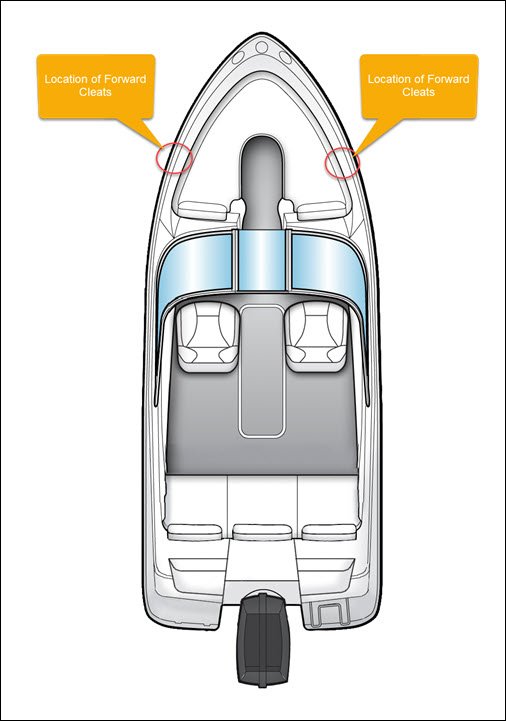

My hack for safer anchoring is to connect the anchor line to the bow ring while still tying off to the forward cleat. This puts the actual anchor strain on the centerline bow ring.
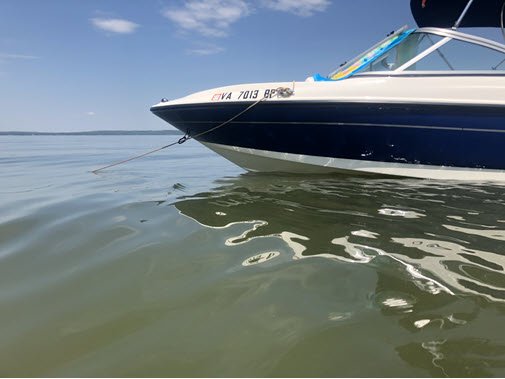

I use a standard aluminum rock climber’s carabiner to connect the anchor line to bow ring. This style of carabiner is capable of handling the stress of anchorage. I run the anchor line through the carabiner and clip the carabiner to the bow ring.
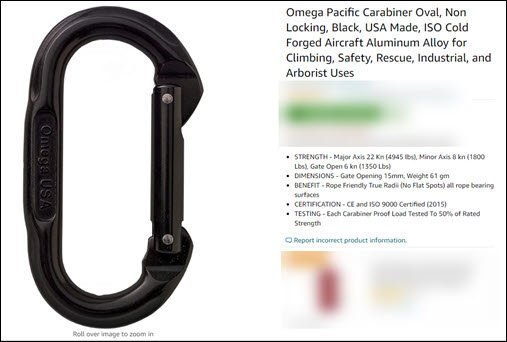
On my 175, I can lean over the bow and clip the carabiner to the bow ring and anchor line at the time I anchor. I realize not all boats are designed like this (I couldn’t do this with my first boat). If you can’t reach the bow ring from inside the boat, you will have to plan in advance. Rig up the anchor line through the bow ring with carabiner before you launch the boat off the trailer, and keep the anchor rig out of the way of your passengers as best you can while the anchor is not in use.
Anchor Line Markings
Typically, you’ll only anchor in five to ten feet of water, but a 7:1 ratio still means 35 to 70 feet of anchor line out. The problems comes in knowing how much line you’ve let out. A motorized winch can measure how much line you’ve let out. Without a winch…not so much. So I’ve marked my anchor line with tape stripes to indicate the line length.
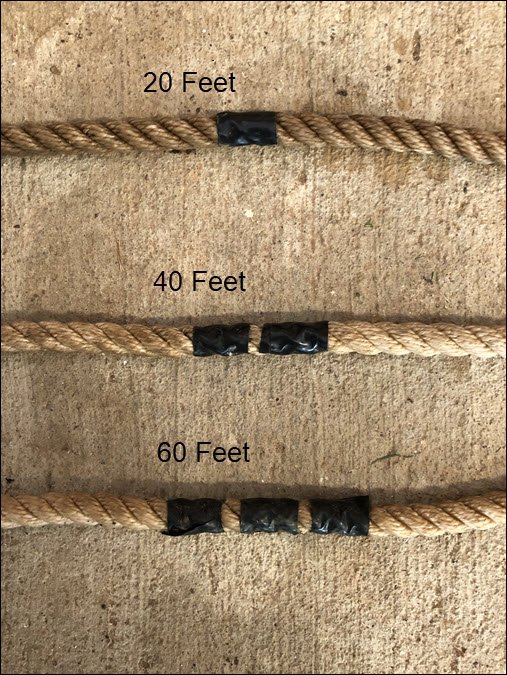
I used black electrical tape wrapped around my anchor line every 20 feet. The glue used on electrical tape is waterproof and the tape itself is pretty durable. I use a simple code to signify length. My first 20 foot marker is one stripe. The 40 foot marker is two parallel stripes, and so on. My primary anchor has 125 feet of line, so I only need five sets of tape marks.
Anchor Storage
Storing your anchor and anchor rode can be a problem. Just coiling up the line and throwing your anchor rig into a storage pocket can lead to problems. The line can easily tangle in the anchor or other stuff in the same storage space. You really don’t want to be in the situation of trying to untangle your anchor line while drifting helplessly in an anchorage area with lots of other other boats already anchored. Not only is this embarrassing, you might endanger some other boat.
Another issue is keeping the boat clean. Pulling up your anchor rig includes pulling up bottom muck that does not wash off easily. Dumping all this in your boat makes a mess for later cleanup. Since you probably don’t have a dedicated anchor locker, you also get muck on everything else stored with your anchor rig.
I took a page from small sailboat operators and keep my anchor rig in a “rode bag,” a cloth bag just large enough to hold the anchor line, chain, and anchor. You can purchase these at marine supply stores, but if you are handy with a needle and thread, they’re easy enough to make. They come in two styles; with or without a hole in the bottom so you can thread the end of your anchor line out. I have one rode bag of each type and found a hole in the bottom doesn’t really matter.
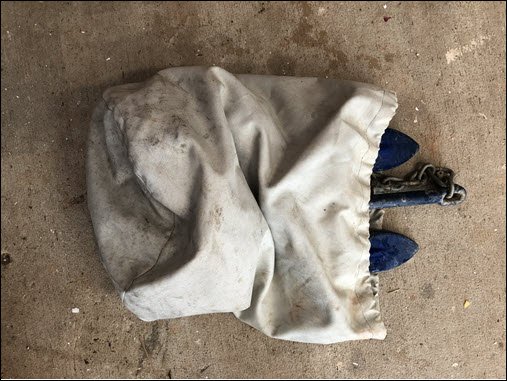
Four feet of chain, and a Five Pound Bayliner-Provided Fluke Anchor
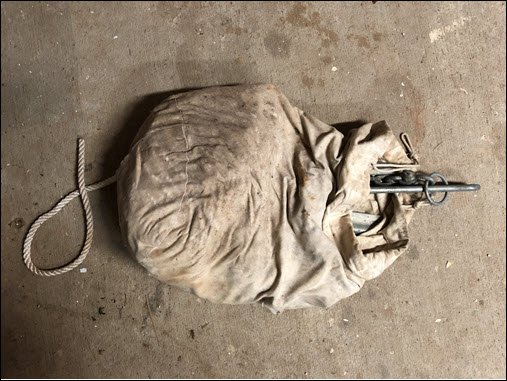
Five Feet of Chain, and a Four Pound Slip-Ring Fluke Anchor
When using a rode bag, just pack your line in, then put the anchor and chain on top. In use, pull out the anchor with chain and toss overboard, followed by the length of line you need. Make sure you tie off the line to your cleat. When you pull up your anchor, pack the (wet) line in the rode bag followed by your chain and anchor. Whatever muck you can’t wash off stays inside the rode bag, and you can clean that out later when everything is dry.
Happy Boating!